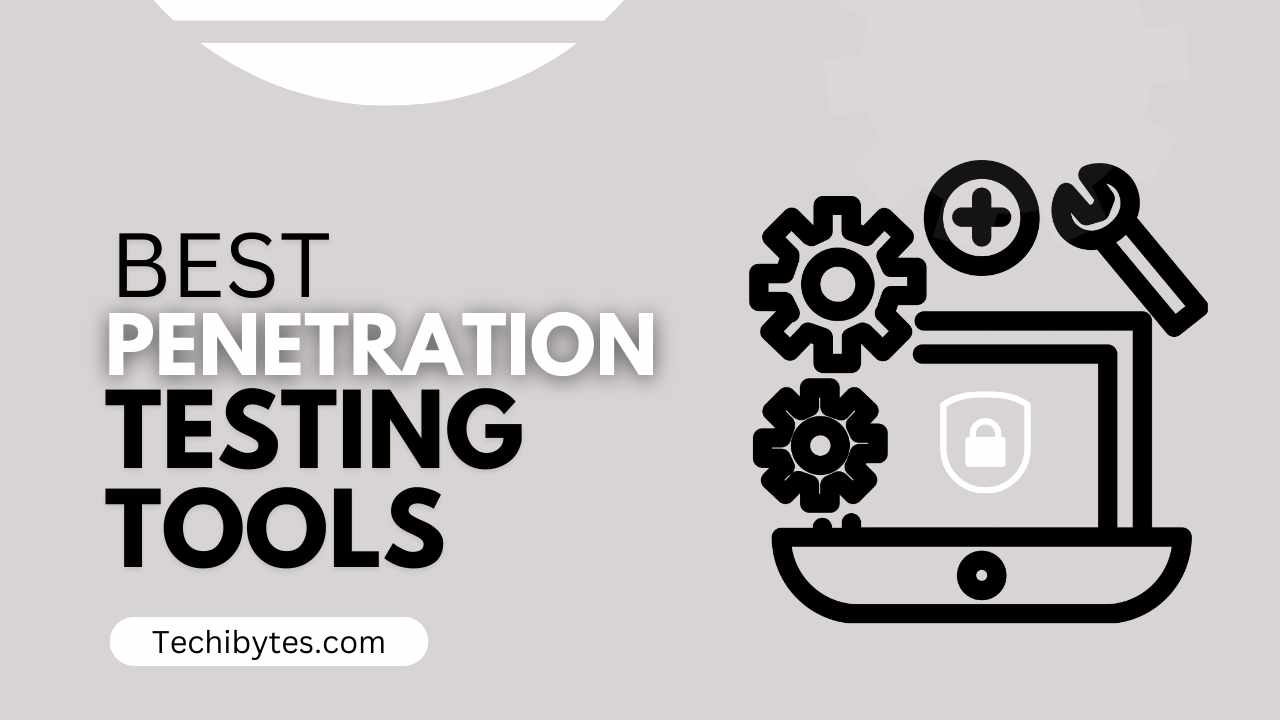Security experts and companies alike must keep up with the most recent technologies and tactics to tackle the increasing number of sophisticated cyber threats.
This has made them very curious to know exactly what kinds of security challenges they are dealing with, even if they are aware that they can’t make every system 100% secure. Hence the need for penetration testing tools.
In this post, we’ll be taking a look at some of the best penetration testing tools that can help you prevent any form of cyber threat. Because this post will be very informative, we’ll urge you to read it to the end.
Table of Contents
WHAT IS PENETRATION TESTING?
Penetration testing can also be called pen testing. Pen testing is a legitimate cyber attack that is simulated on a system to evaluate the security and IT infrastructure of the business by properly exploiting its weaknesses. These flaws may exist in operating systems, programs, services, etc.
The tests frequently model different threats that might pose a threat to the business. A pen test could be useful for evaluating a system’s robustness to see if it can fend off attacks from both authenticated and unauthenticated users.
There are often numerous stages to the penetration testing process. The tester or penetration testing tools start by learning as much as they can about the target and finding potential entry points.
The tester then tries to break into the area being tested. The tester then creates a report outlining the vulnerabilities discovered and making recommendations to strengthen the environment’s security.
WHAT ARE PENETRATION TESTING TOOLS?
Penetration testing tools are tools used in penetration testing (pen test) to automate some operations, increase testing efficiency, and detect flaws that could be challenging to find using only human analytical techniques.
Static analysis tools and dynamic analysis tools are the two frequently used penetration testing techniques. Some penetration testing tools analyze both dynamic and static code, identifying security flaws such as malicious code as well as functional gaps that could result in security breaches.
Professionals use automated penetration testing tools to identify programs’ vulnerabilities. These technologies aid in code scanning to discover any application code flaws that can result in a security breach of any kind. Additionally, they look at various data encryption techniques and can decode values that help identify security flaws in the system.
Through hard-coded user names and passwords, penetration testing tools can evaluate whether a piece of software has any application backdoors and whether there is enough encryption being used.
Penetration testers and developers can spend more time fixing issues and less time sorting through non-threats since most penetration testing tools produce fewer false positives.
You Might Like: 10 Best Free Fake Website Checkers
BEST PENETRATION TESTING TOOLS
There are tons of penetration testing tools, but below is a list of the best penetration testing tools:
1. NMAP
The first tool on our list of penetration testing tools is NMAP, which means Network Mapper. It aids network mapping by scanning ports, locating operating systems, and compiling a list of hardware and the services it supports.
NMAP delivers differently constructed packets that return with IP addresses and other data for various transport layer protocols. This data can be used for security auditing, host discovery, OS fingerprinting, and service discovery.
NMAP enables security administrators to compile a list of all the hardware, software, and services linked to a network, allowing them to identify potential vulnerabilities.
Key Features
- on Linux, Windows, and MacOS
- typically examine each network protocol’s top 1000 ports
- NMap is frequently used for port scanning and network mapping. The manual pentest effort includes these components.
- occasionally displays erroneous insights and misleading positives
- lacks Management of vulnerabilities
- has an indirect connection to compliance reporting
Price: Free
2. Indusface WAS
Indusface WAS is next on our list of best penetration testing tools. Indusface WAS integrates manual penetration testing with its DAST scanner for web application vulnerability scanner that discovers and reports vulnerabilities based on OWASP top 10 and also includes a website reputation check of links, malware, and defacement checks of the website in every scan. The DAST scanner also performs manual penetration testing.
Each client who orders a manual penetration test for a web, mobile, or API application is given a free automated scanner that they may utilize whenever they want for the entire year.
The company has offices in Bengaluru, Vadodara, Mumbai, Delhi, and San Francisco in addition to its headquarters in India. Over 5000 clients from more than 90 countries around the world use the company’s services.
Key Features
- With unrestricted manual validation of vulnerabilities discovered in the DAST scan report, there are zero false positive guarantees.
- 24/7 help to talk about remediation recommendations and vulnerability proofs.
- No credit card is needed during the free trial and it includes a thorough single scan.
- Instant virtual patching with a zero false positive guarantee is made possible through integration with Indusface AppTrana WAF.
- Support for gray-box scanning with the option to add credentials and run scans.
Price: Free
3. Metasploit
Next on our list of best penetration testing tools is Metasploit. It is so popular that security experts and hackers alike use the Metasploit framework to find systematically weak points. It is a strong tool that incorporates elements of evasion, anti-forensic, and fuzzing technologies.
It is simple to install, compatible with many different platforms, and highly loved by hackers. It is also a valuable tool for pen testers.
Almost 1,677 exploits and 500 payloads, including Command shell payloads, Dynamic payloads, Meterpreter payloads, and Static payloads, are now included in Metasploit.
Key Features
- Compatible with Unix (including Linux and MacOS), Windows
- Metasploit contains an assortment of tools that can be used for pen testing
- Has no vulnerability management
- Indirectly relates to compliance reporting
Price: Free
You Might Also Like: 15 Best Laptops For Cyber Security
4. Invicti
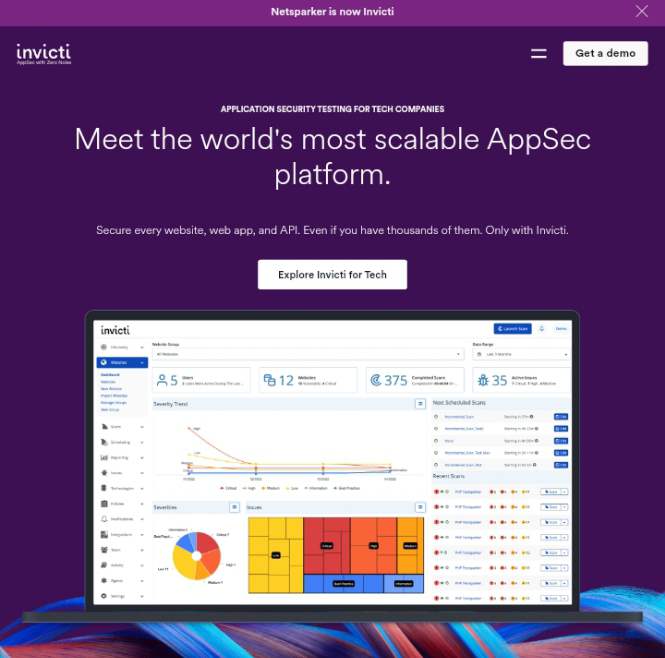
Invicti is one of the best penetration testing tools out there. Invicti is a very accurate automated scanner that can find flaws in online applications and web APIs like SQL Injection and Cross-site Scripting. By independently verifying the discovered vulnerabilities, Invicti establishes that they are genuine and not false positives.
As a result, once a scan is complete, you do not need to waste hours manually confirming the vulnerabilities found. Both Windows software and an online service are offered.
Key Features
- 1000+ online apps may be scanned in less than a day!
- Include more team members to facilitate collaboration and easy sharing of findings.
- A minimal amount of setup is required thanks to automatic scanning.
- investigates online apps for exploitable SQL and XSS flaws.
- Reports on regulatory compliance and legal web applications.
- The use of proof-based scanning technology ensures precise detection.
Price:
- Free trial
- Invicti Pro
- Invicti Enterprise
5. Intruder
The intruder is one of the most robust vulnerability scanners and penetration testing tools. It identifies cybersecurity flaws in your digital estate, highlights the threats they pose, and offers assistance in fixing them before a breach happens. It’s the ideal solution for assisting with the automation of your penetration testing operations.
With more than 11,000 security tests, Intruder gives businesses of all sizes access to enterprise-grade vulnerability assessment. The security checks it does include finding configuration errors, missing security updates, and widespread web application problems like SQL injection and cross-site scripting.
Intruder takes care of the burden of vulnerability management so you can concentrate on what matters by using the same best-in-class scanning engines as huge banks and governmental organizations.
It helps you keep ahead of attackers by proactive scanning your systems for the most recent vulnerabilities and sorting results based on their context to save time.
Key Features
- Integrates with apps like Slack and Jira
- Supports all the main cloud service providers
Price:
- Free trial
- Essential starting at $113.00
- Pro starting at $181.00
- Vanguard at a custom price
6. WireShark
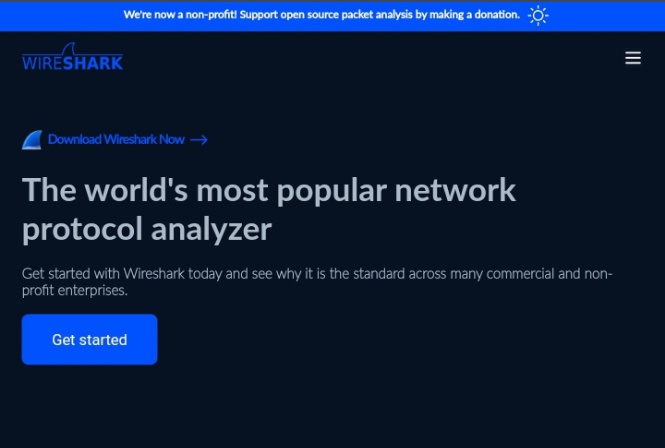
WireShark is one of the famous open-source penetration testing tools primarily used for protocol analysis and microscopic monitoring of network activities. The fact that thousands of security engineers from all around the world collaborate to enhance it makes it one of the network penetration testing tools.
You can inspect protocols, capture and analyze network traffic, and troubleshoot network performance issues using WireShark. The decryption of protocols, as well as the capture of live data from Ethernet, LAN, USB, and other sources, are supplied as additional features.
Additionally, the output can be exported to XML, PostScript, CSV, or plain text. WireShark is not an IDS, which is a crucial distinction to make. It can assist you in visualizing corrupted packets as a protocol analyzer, but it is unable to sound the alarm in the event of harmful activity on the network.
Key Features
- Works with Unix, Windows. Needs libraries like Qt, GLib, & libpcap to run
- Captures live packet data from a network interface
- A useful tool for manual pen testing
- Fairly accurate results
Price: Free
7. Acunetix
Acunetix is a completely automated web vulnerability scanner and one of the best penetration testing tools that finds over 4500 web application vulnerabilities, including all types of SQL Injection and XSS flaws, and reports them.
By automating operations that could take hours to test manually, it enhances the role of a penetration tester by providing accurate results with no false positives at top speed.
Acunetix offers complete support for CMS platforms, HTML5, JavaScript, and single-page applications. It interfaces with well-known WAFs and Issue Trackers and offers sophisticated manual tools for penetration testers.
Key Features
- Compatible with Windows and macOS
- Uses a Web applications
- Has vulnerability management.
- Complies with OWASP, ISO 27001, PCI-DSS, and NIST
Price: $4,495 per website
8. Astra
With an intelligent automated vulnerability scanner and thorough manual pen-testing, Astra’s Pentest is one of the best complete penetration testing tools.
The automated scanner performs all tests necessary to comply with ISO 27001, HIPAA, SOC2, and GDPR in addition to 3000+ tests, security checks for every CVE listed in the OWASP top 10 vulnerabilities, and SANS 25.
Users can see vulnerability studies, assign vulnerabilities to team members, and work with security specialists using the interactive pentest dashboard provided by Astra.
The interfaces with CI/CD platforms, Slack, and Jira can be used by users if they don’t want to return to the dashboard each time they want to utilize the scanner or assign a vulnerability to a team member.
Key Features
- 3000+ tests scanning for CVEs in OWASP top 10, SANS 25
- All tests required for ISO 27001, HIPAA, SOC2, GDPR
- Integration of the vulnerability scanner with GitLab, GitHub, Slack, & Jira
- Zero false positives ensured by manual pen-testers
- Scans progressive web apps and single-page apps
Price: $199 per month
9. Nikto
Nikto is next on our list of the best penetration testing tools. A web server can be thoroughly tested using the open-source penetration testing tool Nikto, which can detect about 7000 dangerous files and programs.
This includes tests for out-of-date server versions, over 6,700 potentially harmful files and programs, and version-specific issues on over 270 server versions: versions of servers for FTP, ProFTPd, MySQL, Courier, Netscape, iPlanet, Lotus, BIND, MyDoom, and other services.
It also scans for more than 6,000 vulnerabilities and the identification of version-specific issues.
Key Features
- Full HTTP proxy support
- Checks for outdated server components
- Save reports in plain text, XML, HTML, NBE, or CSV
- Template engine to easily customize reports
- Scan multiple ports on a server, or multiple servers via input file (including Nmap output)
- LibWhisker’s IDS encoding techniques
- Easily updated via the command line
- Identifies installed software via headers, favicons, and files
- Host authentication with Basic and NTLM
Price: Open source
You Might Like: Top 5 Frequently Asked Questions in Cybersecurity Interview
10. Core Impact
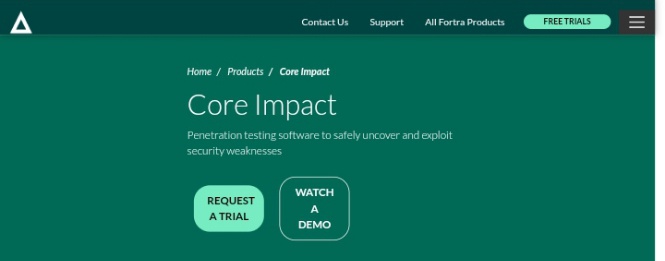
With more than 20 years on the market, Core Impact has one of the strongest penetration testing tools created for security teams to safely carry out advanced tests using the same methods as today’s threat actors.
Pen testers can concentrate on more complicated problems since Rapid Penetration Tests (RPTs) automate time-consuming and repetitive processes.
The cybersecurity professionals at Core Security themselves created and evaluated the collection of commercial-grade exploits. supplying real-time updates and tests for new systems as they become available, as well as technical assistance for these exploits and the platform they are used on.
Pricing schemes are offered for security consultancies as well as corporate ones. Regardless of the sector you work in, Core Impact works to identify vulnerabilities before attackers do, and it has robust reporting tools that may be used to confirm compliance with sector rules.
Key Features
- Robust error prevention
- Automated retesting and remediation and validation
- Guided automation
Price: Free (Trial period)
11. BeEF
BeEF is one of the best penetration testing tools for testing web browsers. It can be adapted for stopping web-based attacks and might help clients on mobile devices.
The Browser Exploitation Framework, or BeEF, uses GitHub to find flaws. BeEF is made to look into vulnerabilities outside the client system and network boundary. The framework will instead examine exploitability with a single source, the web browser.
Key Features
- Client-side attack vectors can be used to evaluate security posture.
- enables connections with several web browsers, after which it launches directed command modules.
Price: Open source
12. Burp Suite
Burp Suite is also one of the best penetration testing tools. The Burp Suite for developers is available in two editions. The tools required and necessary for scanning operations are included in the free version.
If you require advanced penetration testing, you can choose the second edition instead. For testing web-based apps, use this tool.
Tools are available to examine requests made between a browser and destination servers as well as to map the attack surface. The bulk of information security specialists uses the framework, which employs Web Penetration Testing on the Java platform.
Key Features
- able to automatically crawl websites and online apps.
- accessible on Linux, OSX, and Windows.
- Complies with PCI-DSS, OWASP Top 10, HIPAA, GDPR
Price: $449 per user per year
You Might Like: Top 12 Cyber Security Companies in Canada
13. Hexway
Next on our list of best penetration testing tools is Hexway. Hexway offers users two self-hosted workspaces designed for vulnerability management and penetration testing (PTaaS).
It’s designed to aggregate and normalize data from penetration testing tools like Nmap, Nessus, Burp, and Metasploit so that users may access it quickly and easily.
Hive includes a large toolbox to interact with security data and provide work results in real time because Hexway is created for pen testers who understand how valuable time is.
Additionally, Hexway is about improved workflow and practical approaches that help speed up testing and increase revenue for the business. It isn’t simply about pentest results or data aggregation.
Key Features
- All security data in one place
- Issues knowledge base
- Integrations with tools (Nessus, Nmap, Burp, etc.)
- Checklists & pentest methodologies
- API (for custom tools)
- Team collaboration
- Project dashboards
- Scan comparisons
- LDAP & Jira integration
Price:
- The community at $0
- Pentest at $78 per user per month
- Enterprise plan at a custom price
14. W3AF
The Web Application Attack and Audit Framework (W3AF) is one of the penetration testing tools that are perfect for auditing and pentesting web applications. The framework can be extended using modules that were made to be simple to configure and grow.
By utilizing the Python API, the framework may be utilized both manually and automatically. The tool can spot about 200 potential faults in web applications.
Easy expansion, cookie handling, and proxy support are important features. By providing recommendations, it improves any platform used for pen testing.
Key Features
- Available on Windows, OS X, Linux, FreeBSD and OpenBSD
- Scans as a Web application
- May give false positives.
Price: Open-source
15. Aircrack
Aircrack is next on our list of best penetration testing tools. Aircrack was created to find security flaws in wireless connections by capturing data packets and exporting them as text files for analysis. With support for WEP dictionary attacks, this program works with many different operating systems and platforms.
It supports many cards and drivers and delivers faster tracking than the majority of other penetration tools. The suite can crack WEP using a password dictionary and statistical methods after intercepting the WPA handshake.
Key Features
- works with Solaris, Linux, Windows, Mac OS X, FreeBSD, NetBSD, and OpenBSD.
- This utility allows you to export data and capture packets.
- It is intended for evaluating driver capabilities as well as wifi gadgets.
- focuses on several security aspects, including testing, monitoring, attacking, and cracking.
- Attacking techniques include de-authentication, creating phony access points, and replay attacks.
Price: Open-source
16. Cobalt
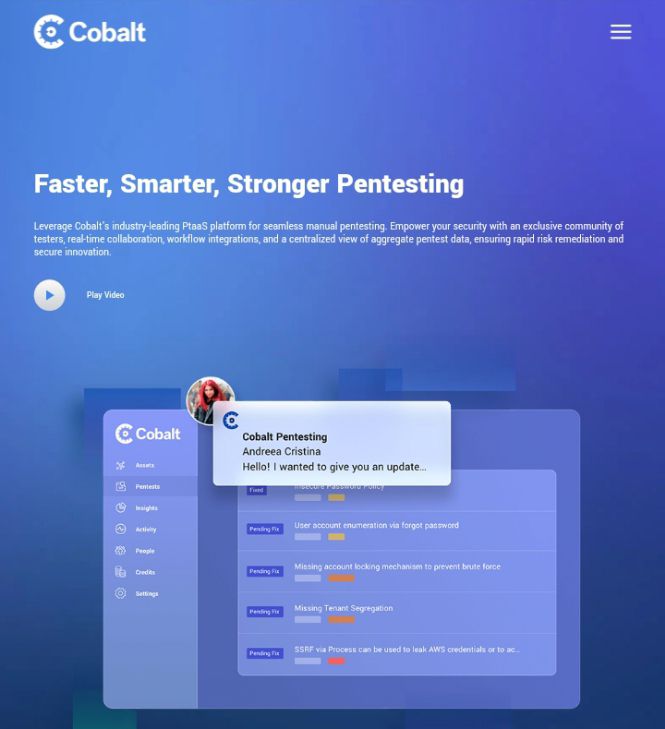
Wrapping up our list of the best penetration testing tools is Cobalt. Cobalt is one of the best manual penetration testing tools which enables you to connect with testers based on your security testing requirements. They have tools that make it possible to complete a pentest quickly.
This automated tool is typically used for web applications. The infrastructure of an organization is managed by it.
Your teams may rapidly begin the remediation with the aid of Cobalt’s SaaS platform, which assists you in gathering real-time insights. You can use it for pen testing and other tasks like cloud scanning.
Key Features
- Available on Linux and Windows
- Web and mobile applications, APIs, Networks, and Cloud
- Supports manual pentest
- Might give false positives
- Has vulnerability management
- Complies with SOC2, PCI-DSS, HIPAA, CREST
Price: $1,650 per credit (8 pen-testing hours)
You Might Also Like: Top CyberSecurity Consulting Firm in Nigeria You Should Know
FAQs
What are the 4 stages of penetration?
The four stages of penetration are planning for penetration, data collection to identify potential vulnerabilities, identifying and characterizing security vulnerabilities, and reporting findings from the penetration test.
What is the difference between QA and pen test?
QA tests concentrate on establishing appropriate procedures and introducing quality standards to stop errors and defects in the product. Overall, QA testing primarily concentrates on processes. Since pen testing is primarily security-oriented, its primary objective would be to find any gaps in coding.
What is the difference between pen testing and automated testing?
Pen testers do employ automated scanning and testing tools even though pen testing is primarily a human process. However, they also go above and beyond the tools and leverage their understanding of the most recent attack strategies to perform more thorough testing than a vulnerability assessment (automated testing).
How much access are pen testers given?
Testers are given varied levels of knowledge about or access to the target system depending on the goals of a pen test. Sometimes the pen testing team starts with one strategy and sticks with it. Sometimes, as the testing team becomes more familiar with the system during the pen test, its strategy changes.
CONCLUSION
Your choice of penetration testing tools has a big impact on the test’s quality and outcomes. A tool may be able to identify a vulnerability or it may completely miss it. We’ll suggest you use a variety of penetration testing tools to get insight into a wider range of weaknesses and vulnerabilities.
We hope our post on the best penetration testing tools was as helpful as promised. Feel free to drop a comment in the comment section below to let us know what you think.
If you liked this article, then please subscribe to our YouTube Channel for videos relating to this article. You can also find us on Twitter and Facebook.
REFERENCE
- https://www.softwaretestingmaterial.com
- https://phoenixnap.com
- https://www.softwaretestinghelp.com
- https://www.getastra.com
